Report on Partnership Working Philosophies in Health and Social Care
VerifiedAdded on 2020/02/05
|12
|4195
|46
Report
AI Summary
This report provides a detailed analysis of partnership working in health and social care. It begins by evaluating the philosophies underpinning such partnerships, including empowerment, autonomy, respect, and power-sharing, and assesses the effectiveness of these relationships. The report then delves into various models of partnership working, such as practical and theoretical models, and reviews relevant legislation and organizational practices. It examines differences in working practices and policies that can affect collaborative efforts. The study further explores the potential outcomes of partnership working for service users, professionals, and organizations, as well as the barriers that can hinder effective collaboration. Finally, the report suggests strategies to improve outcomes and promote successful partnership working in health and social care services. The report covers various aspects like evaluation of partnership working, models, legislation, organizational practices, outcomes, barriers, and strategies for improvement.

Working in Partnership
1
1
Paraphrase This Document
Need a fresh take? Get an instant paraphrase of this document with our AI Paraphraser
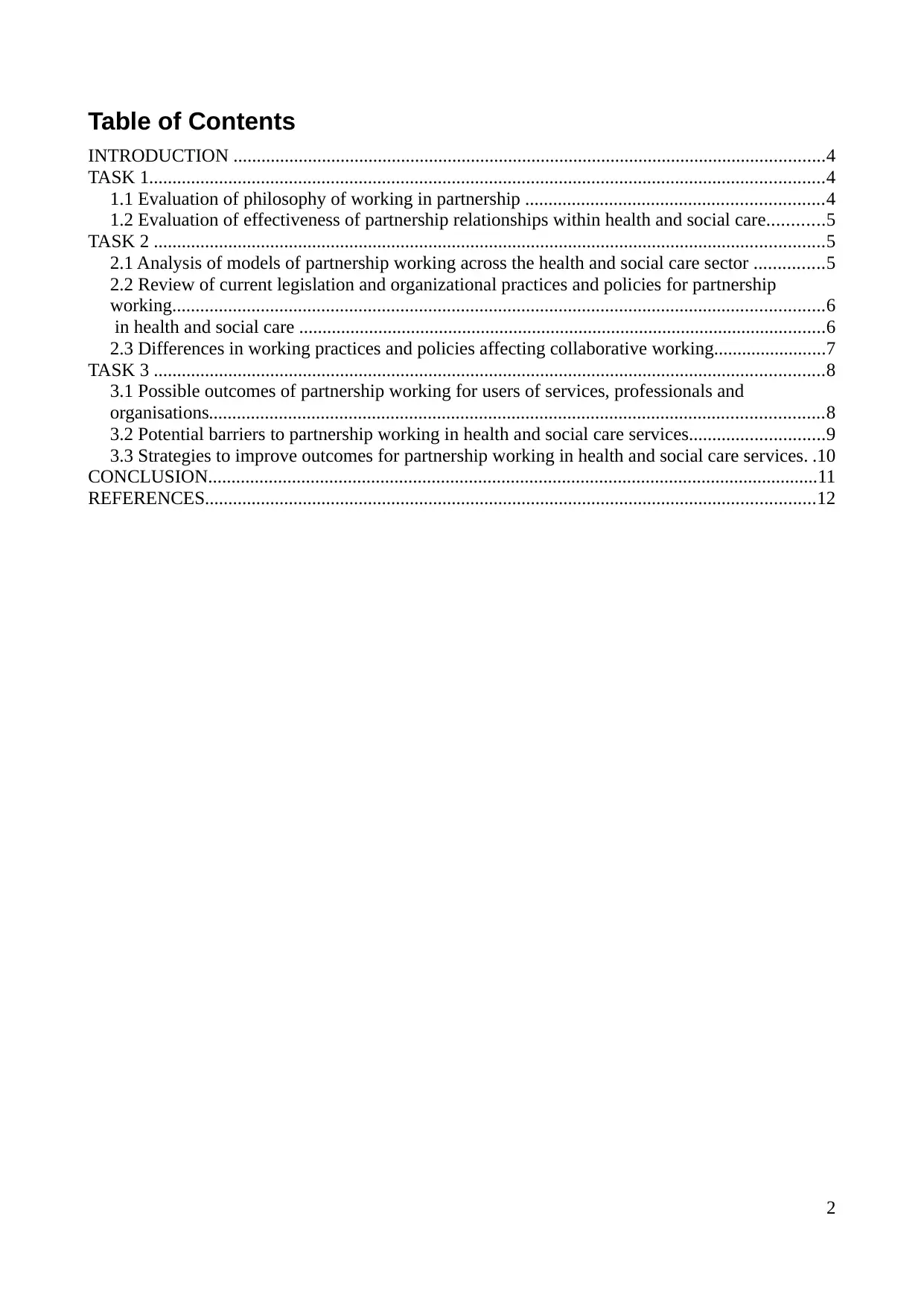
Table of Contents
INTRODUCTION ...............................................................................................................................4
TASK 1.................................................................................................................................................4
1.1 Evaluation of philosophy of working in partnership ................................................................4
1.2 Evaluation of effectiveness of partnership relationships within health and social care............5
TASK 2 ................................................................................................................................................5
2.1 Analysis of models of partnership working across the health and social care sector ...............5
2.2 Review of current legislation and organizational practices and policies for partnership
working............................................................................................................................................6
in health and social care .................................................................................................................6
2.3 Differences in working practices and policies affecting collaborative working........................7
TASK 3 ................................................................................................................................................8
3.1 Possible outcomes of partnership working for users of services, professionals and
organisations....................................................................................................................................8
3.2 Potential barriers to partnership working in health and social care services.............................9
3.3 Strategies to improve outcomes for partnership working in health and social care services. .10
CONCLUSION...................................................................................................................................11
REFERENCES...................................................................................................................................12
2
INTRODUCTION ...............................................................................................................................4
TASK 1.................................................................................................................................................4
1.1 Evaluation of philosophy of working in partnership ................................................................4
1.2 Evaluation of effectiveness of partnership relationships within health and social care............5
TASK 2 ................................................................................................................................................5
2.1 Analysis of models of partnership working across the health and social care sector ...............5
2.2 Review of current legislation and organizational practices and policies for partnership
working............................................................................................................................................6
in health and social care .................................................................................................................6
2.3 Differences in working practices and policies affecting collaborative working........................7
TASK 3 ................................................................................................................................................8
3.1 Possible outcomes of partnership working for users of services, professionals and
organisations....................................................................................................................................8
3.2 Potential barriers to partnership working in health and social care services.............................9
3.3 Strategies to improve outcomes for partnership working in health and social care services. .10
CONCLUSION...................................................................................................................................11
REFERENCES...................................................................................................................................12
2
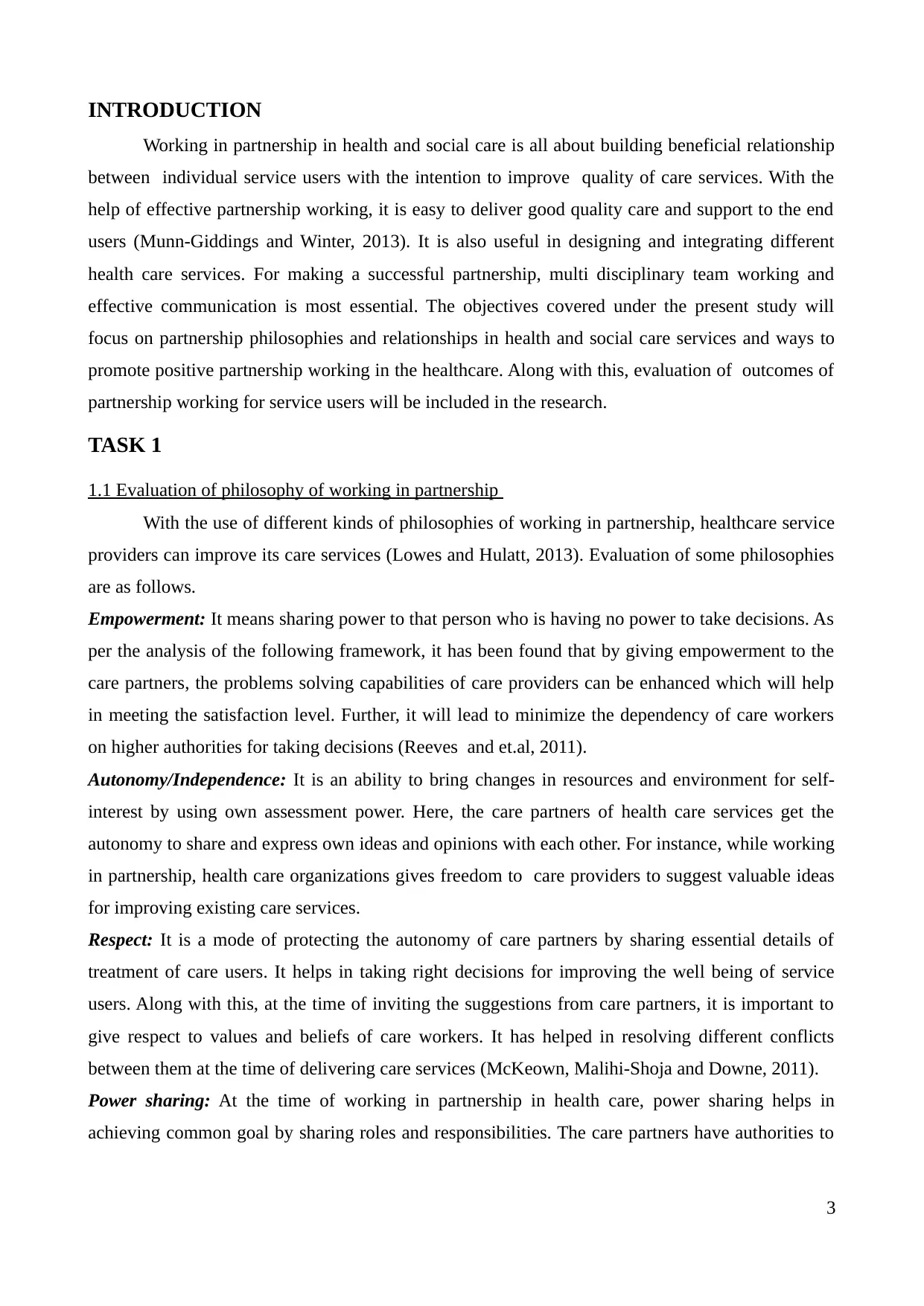
INTRODUCTION
Working in partnership in health and social care is all about building beneficial relationship
between individual service users with the intention to improve quality of care services. With the
help of effective partnership working, it is easy to deliver good quality care and support to the end
users (Munn-Giddings and Winter, 2013). It is also useful in designing and integrating different
health care services. For making a successful partnership, multi disciplinary team working and
effective communication is most essential. The objectives covered under the present study will
focus on partnership philosophies and relationships in health and social care services and ways to
promote positive partnership working in the healthcare. Along with this, evaluation of outcomes of
partnership working for service users will be included in the research.
TASK 1
1.1 Evaluation of philosophy of working in partnership
With the use of different kinds of philosophies of working in partnership, healthcare service
providers can improve its care services (Lowes and Hulatt, 2013). Evaluation of some philosophies
are as follows.
Empowerment: It means sharing power to that person who is having no power to take decisions. As
per the analysis of the following framework, it has been found that by giving empowerment to the
care partners, the problems solving capabilities of care providers can be enhanced which will help
in meeting the satisfaction level. Further, it will lead to minimize the dependency of care workers
on higher authorities for taking decisions (Reeves and et.al, 2011).
Autonomy/Independence: It is an ability to bring changes in resources and environment for self-
interest by using own assessment power. Here, the care partners of health care services get the
autonomy to share and express own ideas and opinions with each other. For instance, while working
in partnership, health care organizations gives freedom to care providers to suggest valuable ideas
for improving existing care services.
Respect: It is a mode of protecting the autonomy of care partners by sharing essential details of
treatment of care users. It helps in taking right decisions for improving the well being of service
users. Along with this, at the time of inviting the suggestions from care partners, it is important to
give respect to values and beliefs of care workers. It has helped in resolving different conflicts
between them at the time of delivering care services (McKeown, Malihi-Shoja and Downe, 2011).
Power sharing: At the time of working in partnership in health care, power sharing helps in
achieving common goal by sharing roles and responsibilities. The care partners have authorities to
3
Working in partnership in health and social care is all about building beneficial relationship
between individual service users with the intention to improve quality of care services. With the
help of effective partnership working, it is easy to deliver good quality care and support to the end
users (Munn-Giddings and Winter, 2013). It is also useful in designing and integrating different
health care services. For making a successful partnership, multi disciplinary team working and
effective communication is most essential. The objectives covered under the present study will
focus on partnership philosophies and relationships in health and social care services and ways to
promote positive partnership working in the healthcare. Along with this, evaluation of outcomes of
partnership working for service users will be included in the research.
TASK 1
1.1 Evaluation of philosophy of working in partnership
With the use of different kinds of philosophies of working in partnership, healthcare service
providers can improve its care services (Lowes and Hulatt, 2013). Evaluation of some philosophies
are as follows.
Empowerment: It means sharing power to that person who is having no power to take decisions. As
per the analysis of the following framework, it has been found that by giving empowerment to the
care partners, the problems solving capabilities of care providers can be enhanced which will help
in meeting the satisfaction level. Further, it will lead to minimize the dependency of care workers
on higher authorities for taking decisions (Reeves and et.al, 2011).
Autonomy/Independence: It is an ability to bring changes in resources and environment for self-
interest by using own assessment power. Here, the care partners of health care services get the
autonomy to share and express own ideas and opinions with each other. For instance, while working
in partnership, health care organizations gives freedom to care providers to suggest valuable ideas
for improving existing care services.
Respect: It is a mode of protecting the autonomy of care partners by sharing essential details of
treatment of care users. It helps in taking right decisions for improving the well being of service
users. Along with this, at the time of inviting the suggestions from care partners, it is important to
give respect to values and beliefs of care workers. It has helped in resolving different conflicts
between them at the time of delivering care services (McKeown, Malihi-Shoja and Downe, 2011).
Power sharing: At the time of working in partnership in health care, power sharing helps in
achieving common goal by sharing roles and responsibilities. The care partners have authorities to
3
⊘ This is a preview!⊘
Do you want full access?
Subscribe today to unlock all pages.

Trusted by 1+ million students worldwide
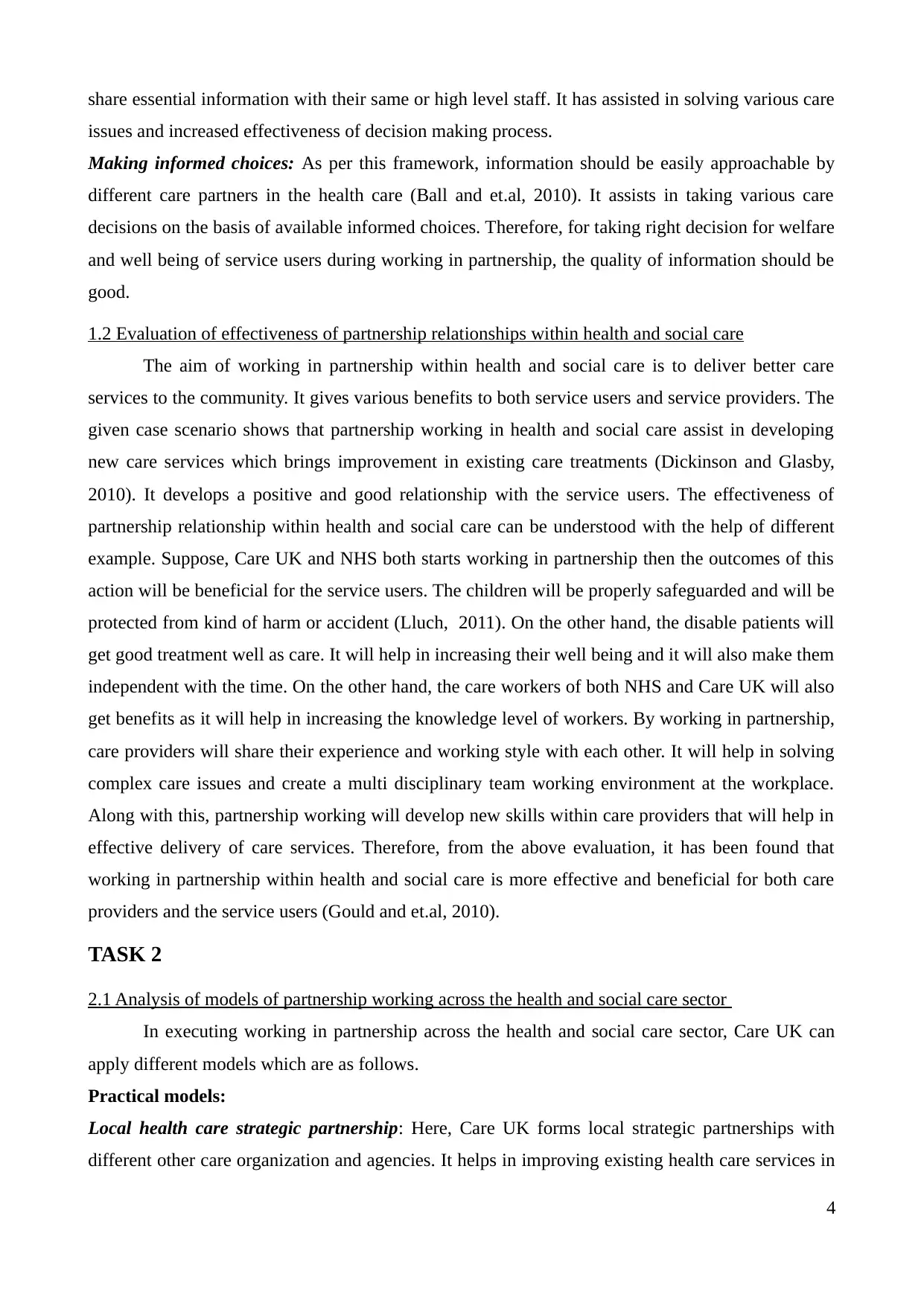
share essential information with their same or high level staff. It has assisted in solving various care
issues and increased effectiveness of decision making process.
Making informed choices: As per this framework, information should be easily approachable by
different care partners in the health care (Ball and et.al, 2010). It assists in taking various care
decisions on the basis of available informed choices. Therefore, for taking right decision for welfare
and well being of service users during working in partnership, the quality of information should be
good.
1.2 Evaluation of effectiveness of partnership relationships within health and social care
The aim of working in partnership within health and social care is to deliver better care
services to the community. It gives various benefits to both service users and service providers. The
given case scenario shows that partnership working in health and social care assist in developing
new care services which brings improvement in existing care treatments (Dickinson and Glasby,
2010). It develops a positive and good relationship with the service users. The effectiveness of
partnership relationship within health and social care can be understood with the help of different
example. Suppose, Care UK and NHS both starts working in partnership then the outcomes of this
action will be beneficial for the service users. The children will be properly safeguarded and will be
protected from kind of harm or accident (Lluch, 2011). On the other hand, the disable patients will
get good treatment well as care. It will help in increasing their well being and it will also make them
independent with the time. On the other hand, the care workers of both NHS and Care UK will also
get benefits as it will help in increasing the knowledge level of workers. By working in partnership,
care providers will share their experience and working style with each other. It will help in solving
complex care issues and create a multi disciplinary team working environment at the workplace.
Along with this, partnership working will develop new skills within care providers that will help in
effective delivery of care services. Therefore, from the above evaluation, it has been found that
working in partnership within health and social care is more effective and beneficial for both care
providers and the service users (Gould and et.al, 2010).
TASK 2
2.1 Analysis of models of partnership working across the health and social care sector
In executing working in partnership across the health and social care sector, Care UK can
apply different models which are as follows.
Practical models:
Local health care strategic partnership: Here, Care UK forms local strategic partnerships with
different other care organization and agencies. It helps in improving existing health care services in
4
issues and increased effectiveness of decision making process.
Making informed choices: As per this framework, information should be easily approachable by
different care partners in the health care (Ball and et.al, 2010). It assists in taking various care
decisions on the basis of available informed choices. Therefore, for taking right decision for welfare
and well being of service users during working in partnership, the quality of information should be
good.
1.2 Evaluation of effectiveness of partnership relationships within health and social care
The aim of working in partnership within health and social care is to deliver better care
services to the community. It gives various benefits to both service users and service providers. The
given case scenario shows that partnership working in health and social care assist in developing
new care services which brings improvement in existing care treatments (Dickinson and Glasby,
2010). It develops a positive and good relationship with the service users. The effectiveness of
partnership relationship within health and social care can be understood with the help of different
example. Suppose, Care UK and NHS both starts working in partnership then the outcomes of this
action will be beneficial for the service users. The children will be properly safeguarded and will be
protected from kind of harm or accident (Lluch, 2011). On the other hand, the disable patients will
get good treatment well as care. It will help in increasing their well being and it will also make them
independent with the time. On the other hand, the care workers of both NHS and Care UK will also
get benefits as it will help in increasing the knowledge level of workers. By working in partnership,
care providers will share their experience and working style with each other. It will help in solving
complex care issues and create a multi disciplinary team working environment at the workplace.
Along with this, partnership working will develop new skills within care providers that will help in
effective delivery of care services. Therefore, from the above evaluation, it has been found that
working in partnership within health and social care is more effective and beneficial for both care
providers and the service users (Gould and et.al, 2010).
TASK 2
2.1 Analysis of models of partnership working across the health and social care sector
In executing working in partnership across the health and social care sector, Care UK can
apply different models which are as follows.
Practical models:
Local health care strategic partnership: Here, Care UK forms local strategic partnerships with
different other care organization and agencies. It helps in improving existing health care services in
4
Paraphrase This Document
Need a fresh take? Get an instant paraphrase of this document with our AI Paraphraser
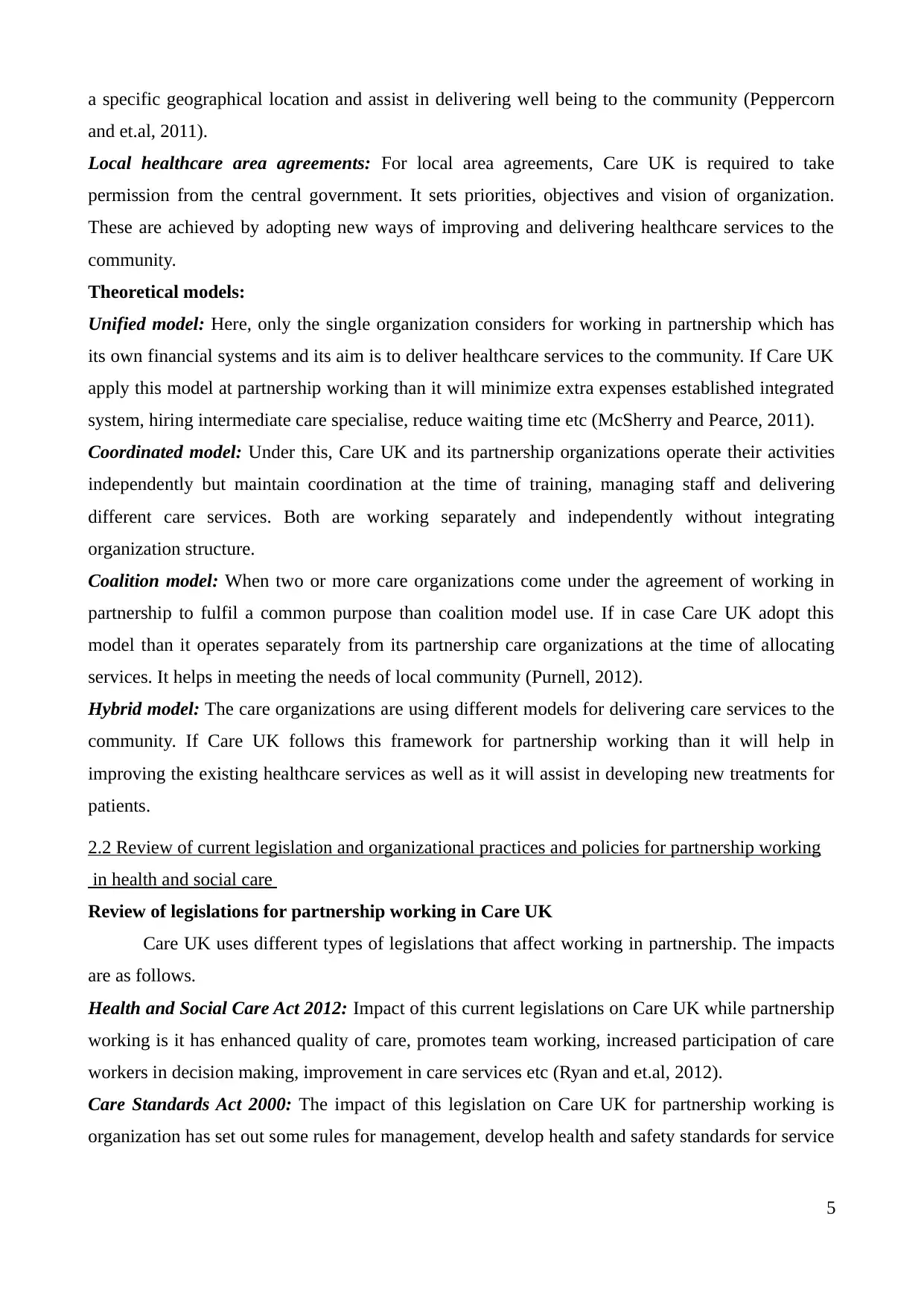
a specific geographical location and assist in delivering well being to the community (Peppercorn
and et.al, 2011).
Local healthcare area agreements: For local area agreements, Care UK is required to take
permission from the central government. It sets priorities, objectives and vision of organization.
These are achieved by adopting new ways of improving and delivering healthcare services to the
community.
Theoretical models:
Unified model: Here, only the single organization considers for working in partnership which has
its own financial systems and its aim is to deliver healthcare services to the community. If Care UK
apply this model at partnership working than it will minimize extra expenses established integrated
system, hiring intermediate care specialise, reduce waiting time etc (McSherry and Pearce, 2011).
Coordinated model: Under this, Care UK and its partnership organizations operate their activities
independently but maintain coordination at the time of training, managing staff and delivering
different care services. Both are working separately and independently without integrating
organization structure.
Coalition model: When two or more care organizations come under the agreement of working in
partnership to fulfil a common purpose than coalition model use. If in case Care UK adopt this
model than it operates separately from its partnership care organizations at the time of allocating
services. It helps in meeting the needs of local community (Purnell, 2012).
Hybrid model: The care organizations are using different models for delivering care services to the
community. If Care UK follows this framework for partnership working than it will help in
improving the existing healthcare services as well as it will assist in developing new treatments for
patients.
2.2 Review of current legislation and organizational practices and policies for partnership working
in health and social care
Review of legislations for partnership working in Care UK
Care UK uses different types of legislations that affect working in partnership. The impacts
are as follows.
Health and Social Care Act 2012: Impact of this current legislations on Care UK while partnership
working is it has enhanced quality of care, promotes team working, increased participation of care
workers in decision making, improvement in care services etc (Ryan and et.al, 2012).
Care Standards Act 2000: The impact of this legislation on Care UK for partnership working is
organization has set out some rules for management, develop health and safety standards for service
5
and et.al, 2011).
Local healthcare area agreements: For local area agreements, Care UK is required to take
permission from the central government. It sets priorities, objectives and vision of organization.
These are achieved by adopting new ways of improving and delivering healthcare services to the
community.
Theoretical models:
Unified model: Here, only the single organization considers for working in partnership which has
its own financial systems and its aim is to deliver healthcare services to the community. If Care UK
apply this model at partnership working than it will minimize extra expenses established integrated
system, hiring intermediate care specialise, reduce waiting time etc (McSherry and Pearce, 2011).
Coordinated model: Under this, Care UK and its partnership organizations operate their activities
independently but maintain coordination at the time of training, managing staff and delivering
different care services. Both are working separately and independently without integrating
organization structure.
Coalition model: When two or more care organizations come under the agreement of working in
partnership to fulfil a common purpose than coalition model use. If in case Care UK adopt this
model than it operates separately from its partnership care organizations at the time of allocating
services. It helps in meeting the needs of local community (Purnell, 2012).
Hybrid model: The care organizations are using different models for delivering care services to the
community. If Care UK follows this framework for partnership working than it will help in
improving the existing healthcare services as well as it will assist in developing new treatments for
patients.
2.2 Review of current legislation and organizational practices and policies for partnership working
in health and social care
Review of legislations for partnership working in Care UK
Care UK uses different types of legislations that affect working in partnership. The impacts
are as follows.
Health and Social Care Act 2012: Impact of this current legislations on Care UK while partnership
working is it has enhanced quality of care, promotes team working, increased participation of care
workers in decision making, improvement in care services etc (Ryan and et.al, 2012).
Care Standards Act 2000: The impact of this legislation on Care UK for partnership working is
organization has set out some rules for management, develop health and safety standards for service
5
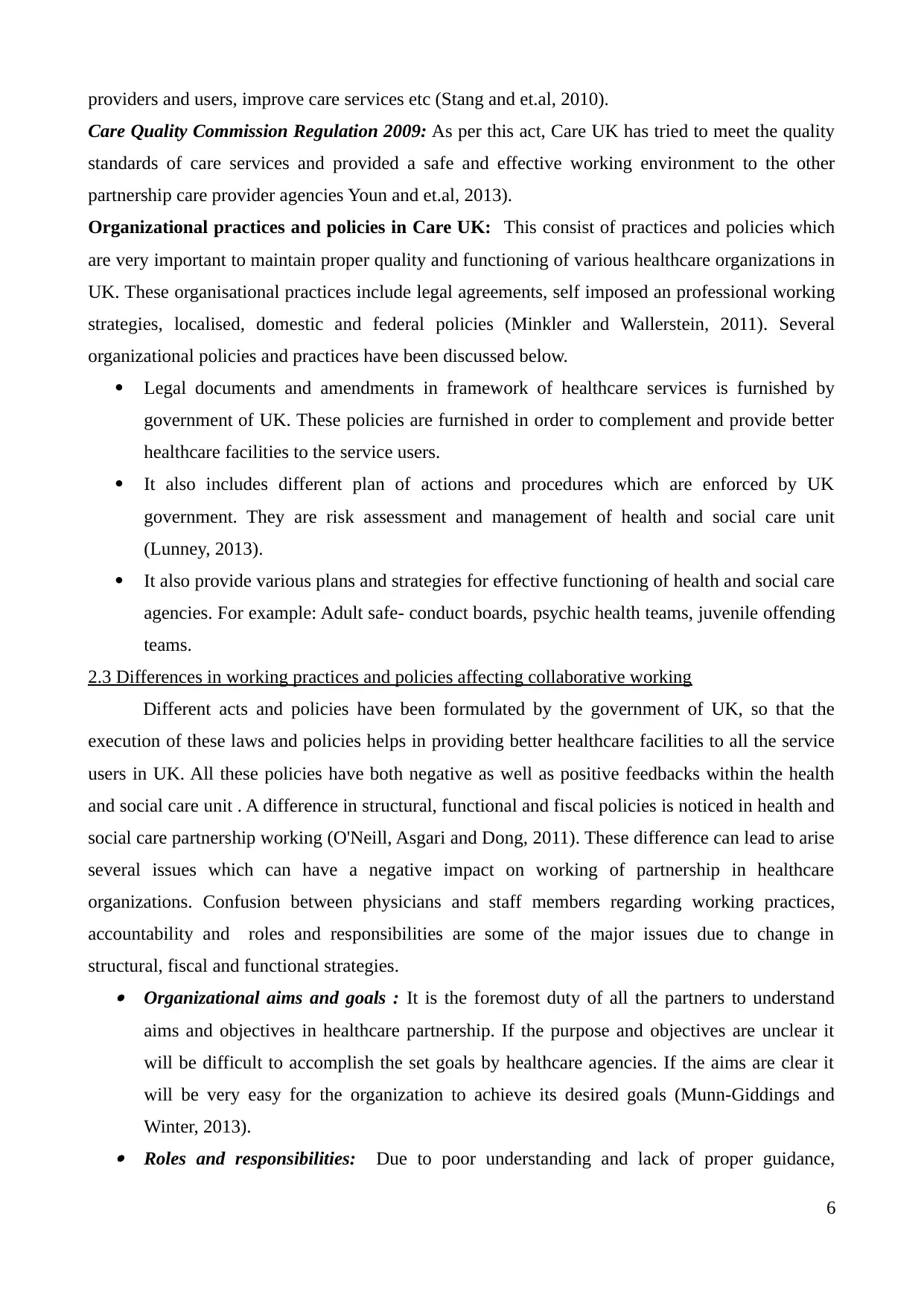
providers and users, improve care services etc (Stang and et.al, 2010).
Care Quality Commission Regulation 2009: As per this act, Care UK has tried to meet the quality
standards of care services and provided a safe and effective working environment to the other
partnership care provider agencies Youn and et.al, 2013).
Organizational practices and policies in Care UK: This consist of practices and policies which
are very important to maintain proper quality and functioning of various healthcare organizations in
UK. These organisational practices include legal agreements, self imposed an professional working
strategies, localised, domestic and federal policies (Minkler and Wallerstein, 2011). Several
organizational policies and practices have been discussed below.
Legal documents and amendments in framework of healthcare services is furnished by
government of UK. These policies are furnished in order to complement and provide better
healthcare facilities to the service users.
It also includes different plan of actions and procedures which are enforced by UK
government. They are risk assessment and management of health and social care unit
(Lunney, 2013).
It also provide various plans and strategies for effective functioning of health and social care
agencies. For example: Adult safe- conduct boards, psychic health teams, juvenile offending
teams.
2.3 Differences in working practices and policies affecting collaborative working
Different acts and policies have been formulated by the government of UK, so that the
execution of these laws and policies helps in providing better healthcare facilities to all the service
users in UK. All these policies have both negative as well as positive feedbacks within the health
and social care unit . A difference in structural, functional and fiscal policies is noticed in health and
social care partnership working (O'Neill, Asgari and Dong, 2011). These difference can lead to arise
several issues which can have a negative impact on working of partnership in healthcare
organizations. Confusion between physicians and staff members regarding working practices,
accountability and roles and responsibilities are some of the major issues due to change in
structural, fiscal and functional strategies. Organizational aims and goals : It is the foremost duty of all the partners to understand
aims and objectives in healthcare partnership. If the purpose and objectives are unclear it
will be difficult to accomplish the set goals by healthcare agencies. If the aims are clear it
will be very easy for the organization to achieve its desired goals (Munn-Giddings and
Winter, 2013). Roles and responsibilities: Due to poor understanding and lack of proper guidance,
6
Care Quality Commission Regulation 2009: As per this act, Care UK has tried to meet the quality
standards of care services and provided a safe and effective working environment to the other
partnership care provider agencies Youn and et.al, 2013).
Organizational practices and policies in Care UK: This consist of practices and policies which
are very important to maintain proper quality and functioning of various healthcare organizations in
UK. These organisational practices include legal agreements, self imposed an professional working
strategies, localised, domestic and federal policies (Minkler and Wallerstein, 2011). Several
organizational policies and practices have been discussed below.
Legal documents and amendments in framework of healthcare services is furnished by
government of UK. These policies are furnished in order to complement and provide better
healthcare facilities to the service users.
It also includes different plan of actions and procedures which are enforced by UK
government. They are risk assessment and management of health and social care unit
(Lunney, 2013).
It also provide various plans and strategies for effective functioning of health and social care
agencies. For example: Adult safe- conduct boards, psychic health teams, juvenile offending
teams.
2.3 Differences in working practices and policies affecting collaborative working
Different acts and policies have been formulated by the government of UK, so that the
execution of these laws and policies helps in providing better healthcare facilities to all the service
users in UK. All these policies have both negative as well as positive feedbacks within the health
and social care unit . A difference in structural, functional and fiscal policies is noticed in health and
social care partnership working (O'Neill, Asgari and Dong, 2011). These difference can lead to arise
several issues which can have a negative impact on working of partnership in healthcare
organizations. Confusion between physicians and staff members regarding working practices,
accountability and roles and responsibilities are some of the major issues due to change in
structural, fiscal and functional strategies. Organizational aims and goals : It is the foremost duty of all the partners to understand
aims and objectives in healthcare partnership. If the purpose and objectives are unclear it
will be difficult to accomplish the set goals by healthcare agencies. If the aims are clear it
will be very easy for the organization to achieve its desired goals (Munn-Giddings and
Winter, 2013). Roles and responsibilities: Due to poor understanding and lack of proper guidance,
6
⊘ This is a preview!⊘
Do you want full access?
Subscribe today to unlock all pages.

Trusted by 1+ million students worldwide
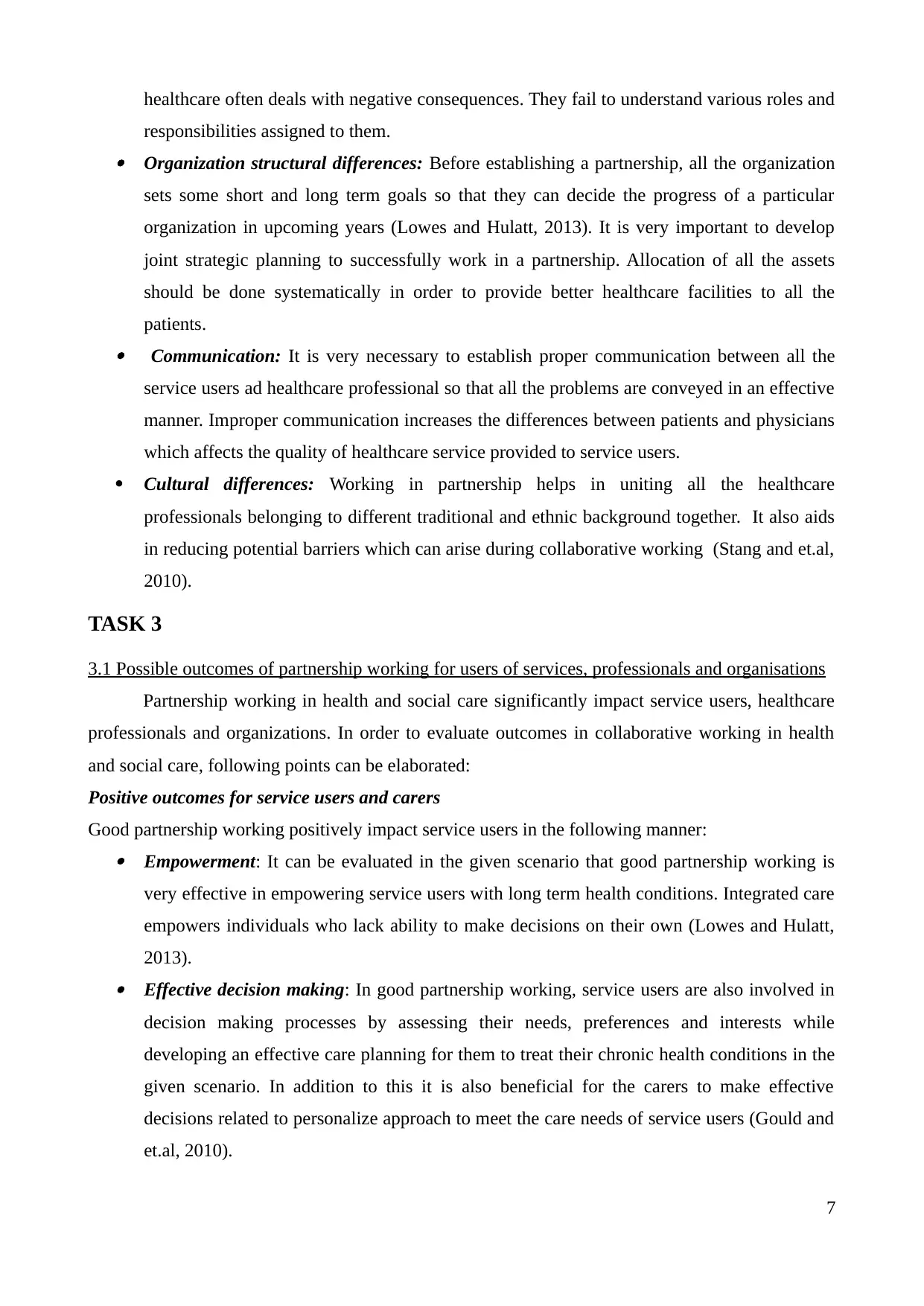
healthcare often deals with negative consequences. They fail to understand various roles and
responsibilities assigned to them. Organization structural differences: Before establishing a partnership, all the organization
sets some short and long term goals so that they can decide the progress of a particular
organization in upcoming years (Lowes and Hulatt, 2013). It is very important to develop
joint strategic planning to successfully work in a partnership. Allocation of all the assets
should be done systematically in order to provide better healthcare facilities to all the
patients. Communication: It is very necessary to establish proper communication between all the
service users ad healthcare professional so that all the problems are conveyed in an effective
manner. Improper communication increases the differences between patients and physicians
which affects the quality of healthcare service provided to service users.
Cultural differences: Working in partnership helps in uniting all the healthcare
professionals belonging to different traditional and ethnic background together. It also aids
in reducing potential barriers which can arise during collaborative working (Stang and et.al,
2010).
TASK 3
3.1 Possible outcomes of partnership working for users of services, professionals and organisations
Partnership working in health and social care significantly impact service users, healthcare
professionals and organizations. In order to evaluate outcomes in collaborative working in health
and social care, following points can be elaborated:
Positive outcomes for service users and carers
Good partnership working positively impact service users in the following manner: Empowerment: It can be evaluated in the given scenario that good partnership working is
very effective in empowering service users with long term health conditions. Integrated care
empowers individuals who lack ability to make decisions on their own (Lowes and Hulatt,
2013). Effective decision making: In good partnership working, service users are also involved in
decision making processes by assessing their needs, preferences and interests while
developing an effective care planning for them to treat their chronic health conditions in the
given scenario. In addition to this it is also beneficial for the carers to make effective
decisions related to personalize approach to meet the care needs of service users (Gould and
et.al, 2010).
7
responsibilities assigned to them. Organization structural differences: Before establishing a partnership, all the organization
sets some short and long term goals so that they can decide the progress of a particular
organization in upcoming years (Lowes and Hulatt, 2013). It is very important to develop
joint strategic planning to successfully work in a partnership. Allocation of all the assets
should be done systematically in order to provide better healthcare facilities to all the
patients. Communication: It is very necessary to establish proper communication between all the
service users ad healthcare professional so that all the problems are conveyed in an effective
manner. Improper communication increases the differences between patients and physicians
which affects the quality of healthcare service provided to service users.
Cultural differences: Working in partnership helps in uniting all the healthcare
professionals belonging to different traditional and ethnic background together. It also aids
in reducing potential barriers which can arise during collaborative working (Stang and et.al,
2010).
TASK 3
3.1 Possible outcomes of partnership working for users of services, professionals and organisations
Partnership working in health and social care significantly impact service users, healthcare
professionals and organizations. In order to evaluate outcomes in collaborative working in health
and social care, following points can be elaborated:
Positive outcomes for service users and carers
Good partnership working positively impact service users in the following manner: Empowerment: It can be evaluated in the given scenario that good partnership working is
very effective in empowering service users with long term health conditions. Integrated care
empowers individuals who lack ability to make decisions on their own (Lowes and Hulatt,
2013). Effective decision making: In good partnership working, service users are also involved in
decision making processes by assessing their needs, preferences and interests while
developing an effective care planning for them to treat their chronic health conditions in the
given scenario. In addition to this it is also beneficial for the carers to make effective
decisions related to personalize approach to meet the care needs of service users (Gould and
et.al, 2010).
7
Paraphrase This Document
Need a fresh take? Get an instant paraphrase of this document with our AI Paraphraser
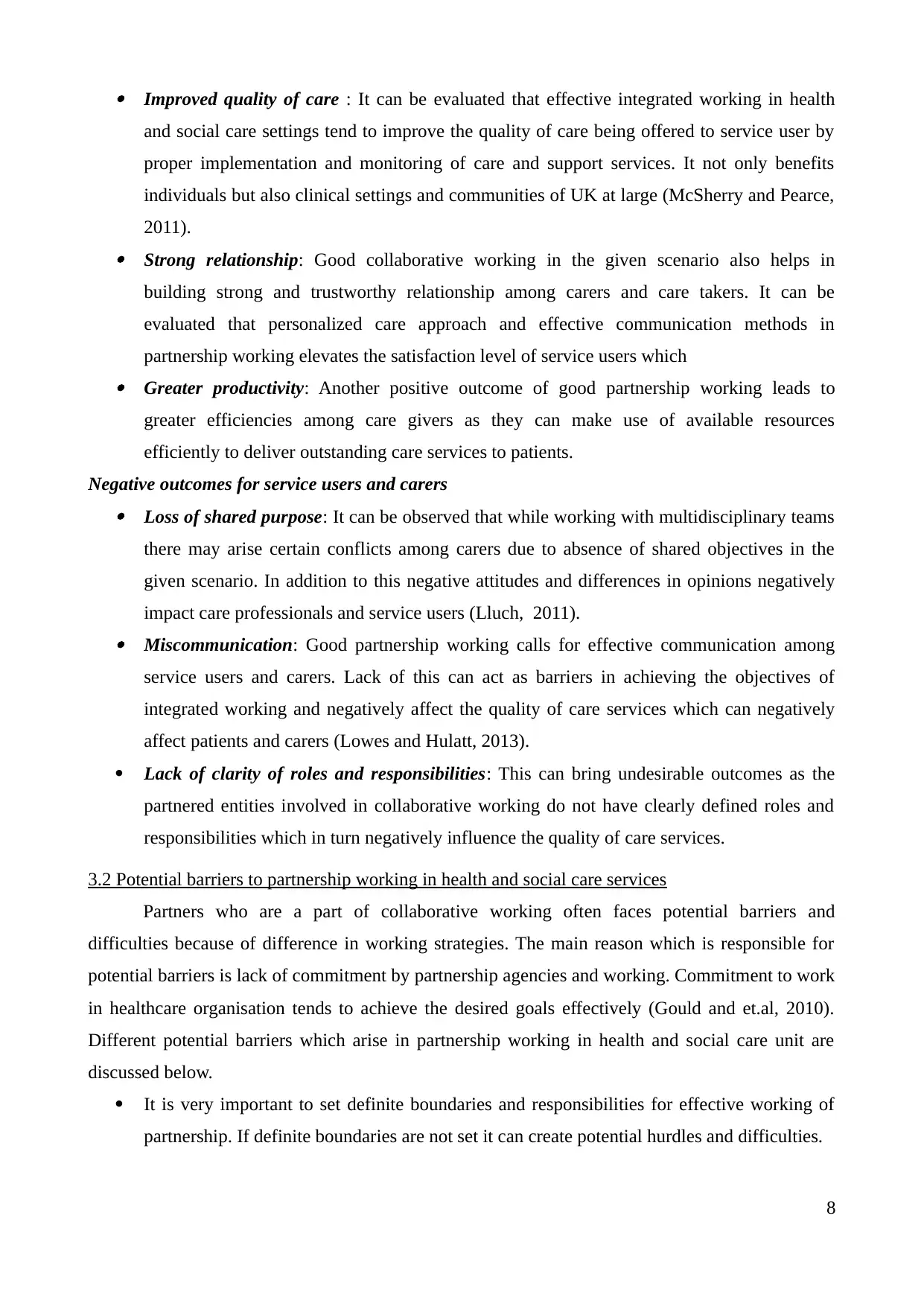
Improved quality of care : It can be evaluated that effective integrated working in health
and social care settings tend to improve the quality of care being offered to service user by
proper implementation and monitoring of care and support services. It not only benefits
individuals but also clinical settings and communities of UK at large (McSherry and Pearce,
2011). Strong relationship: Good collaborative working in the given scenario also helps in
building strong and trustworthy relationship among carers and care takers. It can be
evaluated that personalized care approach and effective communication methods in
partnership working elevates the satisfaction level of service users which Greater productivity: Another positive outcome of good partnership working leads to
greater efficiencies among care givers as they can make use of available resources
efficiently to deliver outstanding care services to patients.
Negative outcomes for service users and carers Loss of shared purpose: It can be observed that while working with multidisciplinary teams
there may arise certain conflicts among carers due to absence of shared objectives in the
given scenario. In addition to this negative attitudes and differences in opinions negatively
impact care professionals and service users (Lluch, 2011). Miscommunication: Good partnership working calls for effective communication among
service users and carers. Lack of this can act as barriers in achieving the objectives of
integrated working and negatively affect the quality of care services which can negatively
affect patients and carers (Lowes and Hulatt, 2013).
Lack of clarity of roles and responsibilities: This can bring undesirable outcomes as the
partnered entities involved in collaborative working do not have clearly defined roles and
responsibilities which in turn negatively influence the quality of care services.
3.2 Potential barriers to partnership working in health and social care services
Partners who are a part of collaborative working often faces potential barriers and
difficulties because of difference in working strategies. The main reason which is responsible for
potential barriers is lack of commitment by partnership agencies and working. Commitment to work
in healthcare organisation tends to achieve the desired goals effectively (Gould and et.al, 2010).
Different potential barriers which arise in partnership working in health and social care unit are
discussed below.
It is very important to set definite boundaries and responsibilities for effective working of
partnership. If definite boundaries are not set it can create potential hurdles and difficulties.
8
and social care settings tend to improve the quality of care being offered to service user by
proper implementation and monitoring of care and support services. It not only benefits
individuals but also clinical settings and communities of UK at large (McSherry and Pearce,
2011). Strong relationship: Good collaborative working in the given scenario also helps in
building strong and trustworthy relationship among carers and care takers. It can be
evaluated that personalized care approach and effective communication methods in
partnership working elevates the satisfaction level of service users which Greater productivity: Another positive outcome of good partnership working leads to
greater efficiencies among care givers as they can make use of available resources
efficiently to deliver outstanding care services to patients.
Negative outcomes for service users and carers Loss of shared purpose: It can be observed that while working with multidisciplinary teams
there may arise certain conflicts among carers due to absence of shared objectives in the
given scenario. In addition to this negative attitudes and differences in opinions negatively
impact care professionals and service users (Lluch, 2011). Miscommunication: Good partnership working calls for effective communication among
service users and carers. Lack of this can act as barriers in achieving the objectives of
integrated working and negatively affect the quality of care services which can negatively
affect patients and carers (Lowes and Hulatt, 2013).
Lack of clarity of roles and responsibilities: This can bring undesirable outcomes as the
partnered entities involved in collaborative working do not have clearly defined roles and
responsibilities which in turn negatively influence the quality of care services.
3.2 Potential barriers to partnership working in health and social care services
Partners who are a part of collaborative working often faces potential barriers and
difficulties because of difference in working strategies. The main reason which is responsible for
potential barriers is lack of commitment by partnership agencies and working. Commitment to work
in healthcare organisation tends to achieve the desired goals effectively (Gould and et.al, 2010).
Different potential barriers which arise in partnership working in health and social care unit are
discussed below.
It is very important to set definite boundaries and responsibilities for effective working of
partnership. If definite boundaries are not set it can create potential hurdles and difficulties.
8
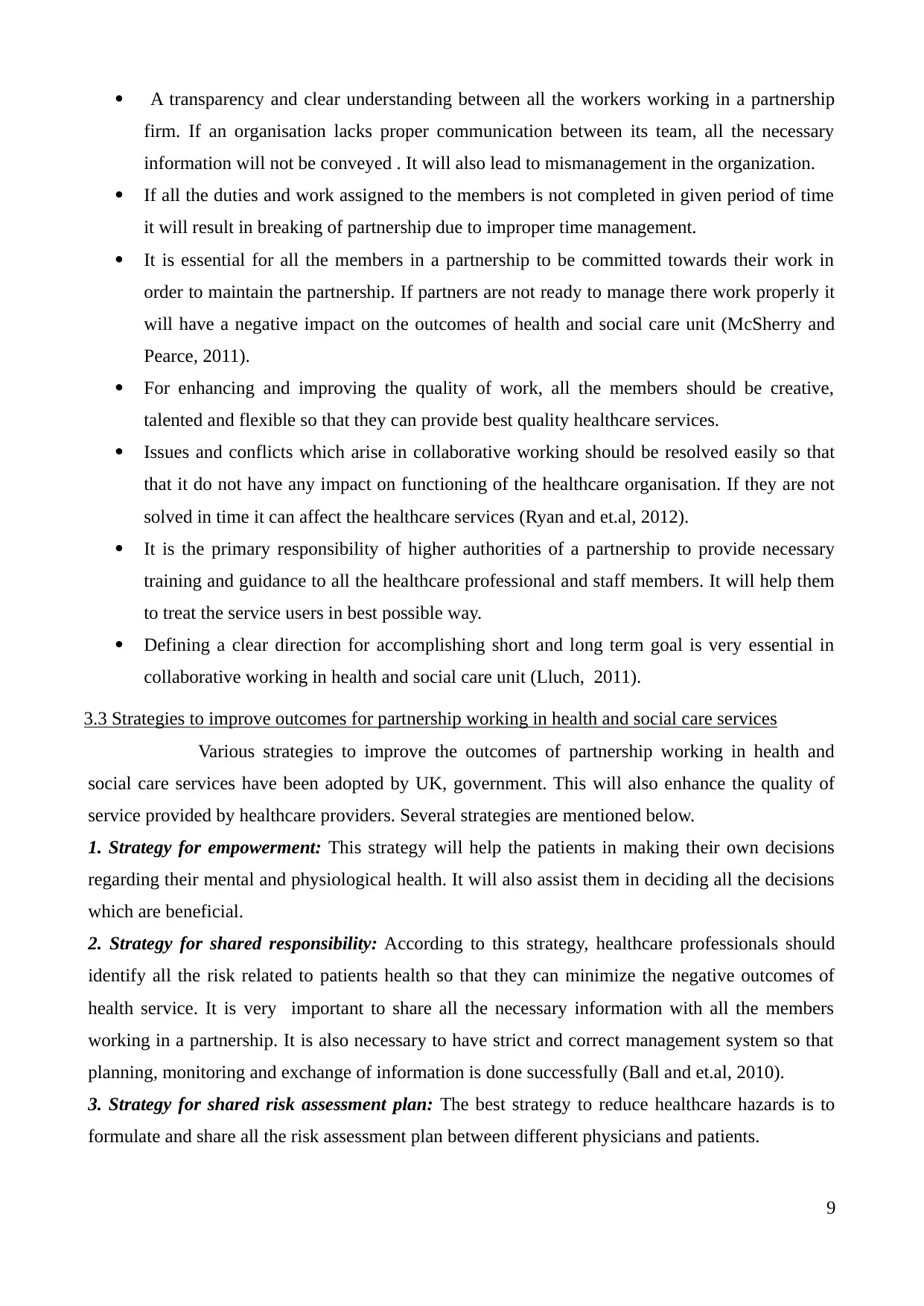
A transparency and clear understanding between all the workers working in a partnership
firm. If an organisation lacks proper communication between its team, all the necessary
information will not be conveyed . It will also lead to mismanagement in the organization.
If all the duties and work assigned to the members is not completed in given period of time
it will result in breaking of partnership due to improper time management.
It is essential for all the members in a partnership to be committed towards their work in
order to maintain the partnership. If partners are not ready to manage there work properly it
will have a negative impact on the outcomes of health and social care unit (McSherry and
Pearce, 2011).
For enhancing and improving the quality of work, all the members should be creative,
talented and flexible so that they can provide best quality healthcare services.
Issues and conflicts which arise in collaborative working should be resolved easily so that
that it do not have any impact on functioning of the healthcare organisation. If they are not
solved in time it can affect the healthcare services (Ryan and et.al, 2012).
It is the primary responsibility of higher authorities of a partnership to provide necessary
training and guidance to all the healthcare professional and staff members. It will help them
to treat the service users in best possible way.
Defining a clear direction for accomplishing short and long term goal is very essential in
collaborative working in health and social care unit (Lluch, 2011).
3.3 Strategies to improve outcomes for partnership working in health and social care services
Various strategies to improve the outcomes of partnership working in health and
social care services have been adopted by UK, government. This will also enhance the quality of
service provided by healthcare providers. Several strategies are mentioned below.
1. Strategy for empowerment: This strategy will help the patients in making their own decisions
regarding their mental and physiological health. It will also assist them in deciding all the decisions
which are beneficial.
2. Strategy for shared responsibility: According to this strategy, healthcare professionals should
identify all the risk related to patients health so that they can minimize the negative outcomes of
health service. It is very important to share all the necessary information with all the members
working in a partnership. It is also necessary to have strict and correct management system so that
planning, monitoring and exchange of information is done successfully (Ball and et.al, 2010).
3. Strategy for shared risk assessment plan: The best strategy to reduce healthcare hazards is to
formulate and share all the risk assessment plan between different physicians and patients.
9
firm. If an organisation lacks proper communication between its team, all the necessary
information will not be conveyed . It will also lead to mismanagement in the organization.
If all the duties and work assigned to the members is not completed in given period of time
it will result in breaking of partnership due to improper time management.
It is essential for all the members in a partnership to be committed towards their work in
order to maintain the partnership. If partners are not ready to manage there work properly it
will have a negative impact on the outcomes of health and social care unit (McSherry and
Pearce, 2011).
For enhancing and improving the quality of work, all the members should be creative,
talented and flexible so that they can provide best quality healthcare services.
Issues and conflicts which arise in collaborative working should be resolved easily so that
that it do not have any impact on functioning of the healthcare organisation. If they are not
solved in time it can affect the healthcare services (Ryan and et.al, 2012).
It is the primary responsibility of higher authorities of a partnership to provide necessary
training and guidance to all the healthcare professional and staff members. It will help them
to treat the service users in best possible way.
Defining a clear direction for accomplishing short and long term goal is very essential in
collaborative working in health and social care unit (Lluch, 2011).
3.3 Strategies to improve outcomes for partnership working in health and social care services
Various strategies to improve the outcomes of partnership working in health and
social care services have been adopted by UK, government. This will also enhance the quality of
service provided by healthcare providers. Several strategies are mentioned below.
1. Strategy for empowerment: This strategy will help the patients in making their own decisions
regarding their mental and physiological health. It will also assist them in deciding all the decisions
which are beneficial.
2. Strategy for shared responsibility: According to this strategy, healthcare professionals should
identify all the risk related to patients health so that they can minimize the negative outcomes of
health service. It is very important to share all the necessary information with all the members
working in a partnership. It is also necessary to have strict and correct management system so that
planning, monitoring and exchange of information is done successfully (Ball and et.al, 2010).
3. Strategy for shared risk assessment plan: The best strategy to reduce healthcare hazards is to
formulate and share all the risk assessment plan between different physicians and patients.
9
⊘ This is a preview!⊘
Do you want full access?
Subscribe today to unlock all pages.

Trusted by 1+ million students worldwide
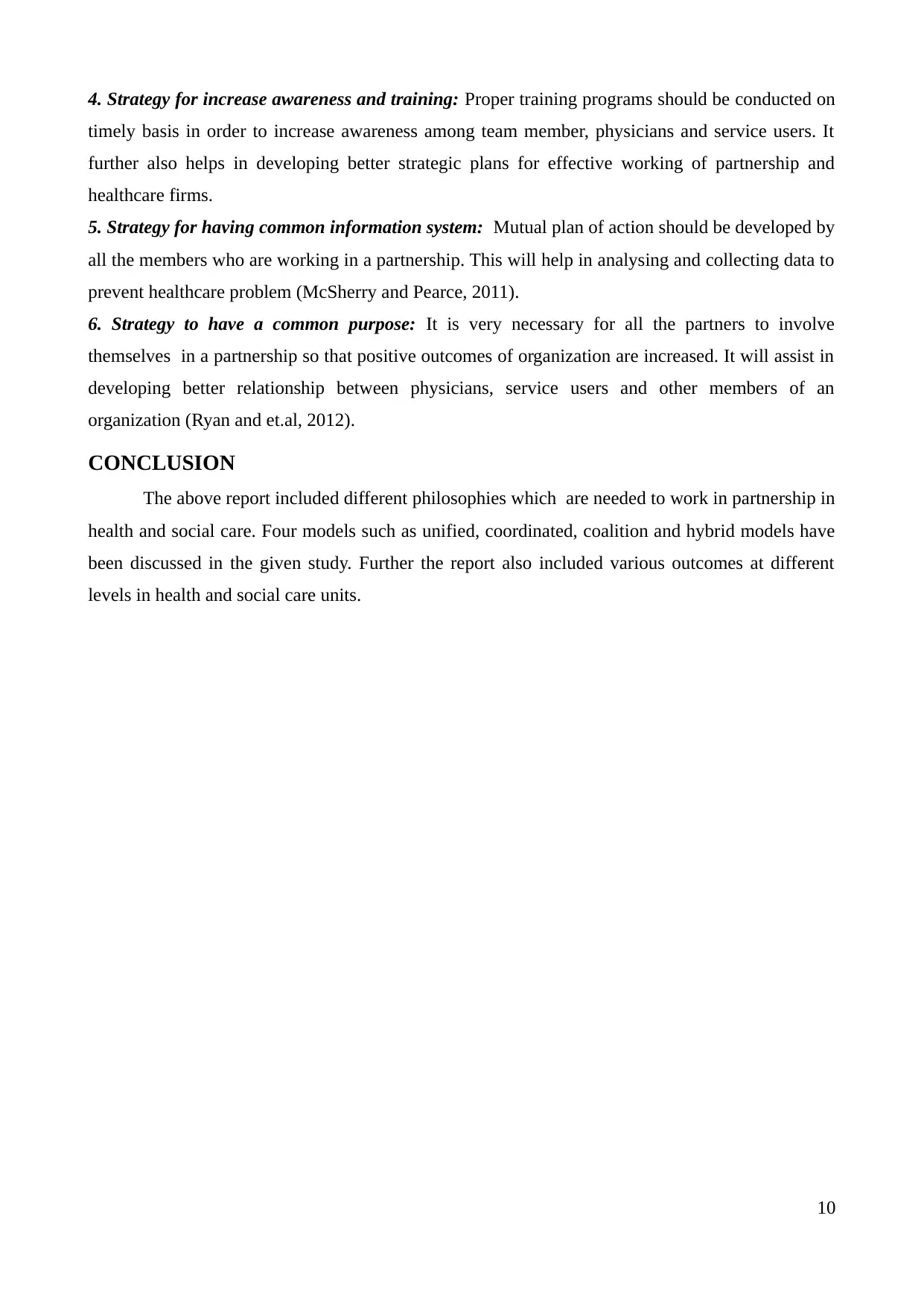
4. Strategy for increase awareness and training: Proper training programs should be conducted on
timely basis in order to increase awareness among team member, physicians and service users. It
further also helps in developing better strategic plans for effective working of partnership and
healthcare firms.
5. Strategy for having common information system: Mutual plan of action should be developed by
all the members who are working in a partnership. This will help in analysing and collecting data to
prevent healthcare problem (McSherry and Pearce, 2011).
6. Strategy to have a common purpose: It is very necessary for all the partners to involve
themselves in a partnership so that positive outcomes of organization are increased. It will assist in
developing better relationship between physicians, service users and other members of an
organization (Ryan and et.al, 2012).
CONCLUSION
The above report included different philosophies which are needed to work in partnership in
health and social care. Four models such as unified, coordinated, coalition and hybrid models have
been discussed in the given study. Further the report also included various outcomes at different
levels in health and social care units.
10
timely basis in order to increase awareness among team member, physicians and service users. It
further also helps in developing better strategic plans for effective working of partnership and
healthcare firms.
5. Strategy for having common information system: Mutual plan of action should be developed by
all the members who are working in a partnership. This will help in analysing and collecting data to
prevent healthcare problem (McSherry and Pearce, 2011).
6. Strategy to have a common purpose: It is very necessary for all the partners to involve
themselves in a partnership so that positive outcomes of organization are increased. It will assist in
developing better relationship between physicians, service users and other members of an
organization (Ryan and et.al, 2012).
CONCLUSION
The above report included different philosophies which are needed to work in partnership in
health and social care. Four models such as unified, coordinated, coalition and hybrid models have
been discussed in the given study. Further the report also included various outcomes at different
levels in health and social care units.
10
Paraphrase This Document
Need a fresh take? Get an instant paraphrase of this document with our AI Paraphraser
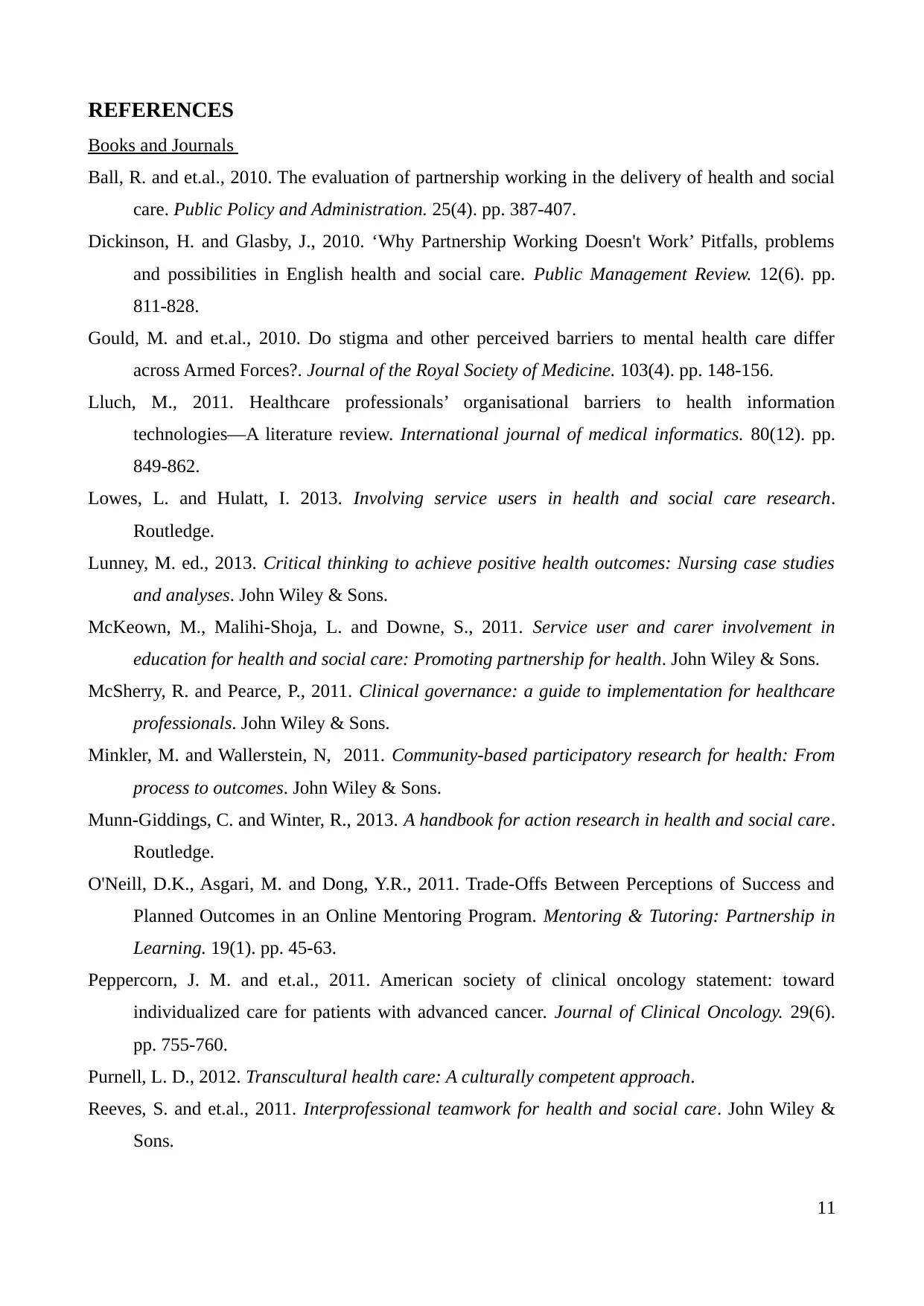
REFERENCES
Books and Journals
Ball, R. and et.al., 2010. The evaluation of partnership working in the delivery of health and social
care. Public Policy and Administration. 25(4). pp. 387-407.
Dickinson, H. and Glasby, J., 2010. ‘Why Partnership Working Doesn't Work’ Pitfalls, problems
and possibilities in English health and social care. Public Management Review. 12(6). pp.
811-828.
Gould, M. and et.al., 2010. Do stigma and other perceived barriers to mental health care differ
across Armed Forces?. Journal of the Royal Society of Medicine. 103(4). pp. 148-156.
Lluch, M., 2011. Healthcare professionals’ organisational barriers to health information
technologies—A literature review. International journal of medical informatics. 80(12). pp.
849-862.
Lowes, L. and Hulatt, I. 2013. Involving service users in health and social care research.
Routledge.
Lunney, M. ed., 2013. Critical thinking to achieve positive health outcomes: Nursing case studies
and analyses. John Wiley & Sons.
McKeown, M., Malihi-Shoja, L. and Downe, S., 2011. Service user and carer involvement in
education for health and social care: Promoting partnership for health. John Wiley & Sons.
McSherry, R. and Pearce, P., 2011. Clinical governance: a guide to implementation for healthcare
professionals. John Wiley & Sons.
Minkler, M. and Wallerstein, N, 2011. Community-based participatory research for health: From
process to outcomes. John Wiley & Sons.
Munn-Giddings, C. and Winter, R., 2013. A handbook for action research in health and social care.
Routledge.
O'Neill, D.K., Asgari, M. and Dong, Y.R., 2011. Trade‐Offs Between Perceptions of Success and
Planned Outcomes in an Online Mentoring Program. Mentoring & Tutoring: Partnership in
Learning. 19(1). pp. 45-63.
Peppercorn, J. M. and et.al., 2011. American society of clinical oncology statement: toward
individualized care for patients with advanced cancer. Journal of Clinical Oncology. 29(6).
pp. 755-760.
Purnell, L. D., 2012. Transcultural health care: A culturally competent approach.
Reeves, S. and et.al., 2011. Interprofessional teamwork for health and social care. John Wiley &
Sons.
11
Books and Journals
Ball, R. and et.al., 2010. The evaluation of partnership working in the delivery of health and social
care. Public Policy and Administration. 25(4). pp. 387-407.
Dickinson, H. and Glasby, J., 2010. ‘Why Partnership Working Doesn't Work’ Pitfalls, problems
and possibilities in English health and social care. Public Management Review. 12(6). pp.
811-828.
Gould, M. and et.al., 2010. Do stigma and other perceived barriers to mental health care differ
across Armed Forces?. Journal of the Royal Society of Medicine. 103(4). pp. 148-156.
Lluch, M., 2011. Healthcare professionals’ organisational barriers to health information
technologies—A literature review. International journal of medical informatics. 80(12). pp.
849-862.
Lowes, L. and Hulatt, I. 2013. Involving service users in health and social care research.
Routledge.
Lunney, M. ed., 2013. Critical thinking to achieve positive health outcomes: Nursing case studies
and analyses. John Wiley & Sons.
McKeown, M., Malihi-Shoja, L. and Downe, S., 2011. Service user and carer involvement in
education for health and social care: Promoting partnership for health. John Wiley & Sons.
McSherry, R. and Pearce, P., 2011. Clinical governance: a guide to implementation for healthcare
professionals. John Wiley & Sons.
Minkler, M. and Wallerstein, N, 2011. Community-based participatory research for health: From
process to outcomes. John Wiley & Sons.
Munn-Giddings, C. and Winter, R., 2013. A handbook for action research in health and social care.
Routledge.
O'Neill, D.K., Asgari, M. and Dong, Y.R., 2011. Trade‐Offs Between Perceptions of Success and
Planned Outcomes in an Online Mentoring Program. Mentoring & Tutoring: Partnership in
Learning. 19(1). pp. 45-63.
Peppercorn, J. M. and et.al., 2011. American society of clinical oncology statement: toward
individualized care for patients with advanced cancer. Journal of Clinical Oncology. 29(6).
pp. 755-760.
Purnell, L. D., 2012. Transcultural health care: A culturally competent approach.
Reeves, S. and et.al., 2011. Interprofessional teamwork for health and social care. John Wiley &
Sons.
11
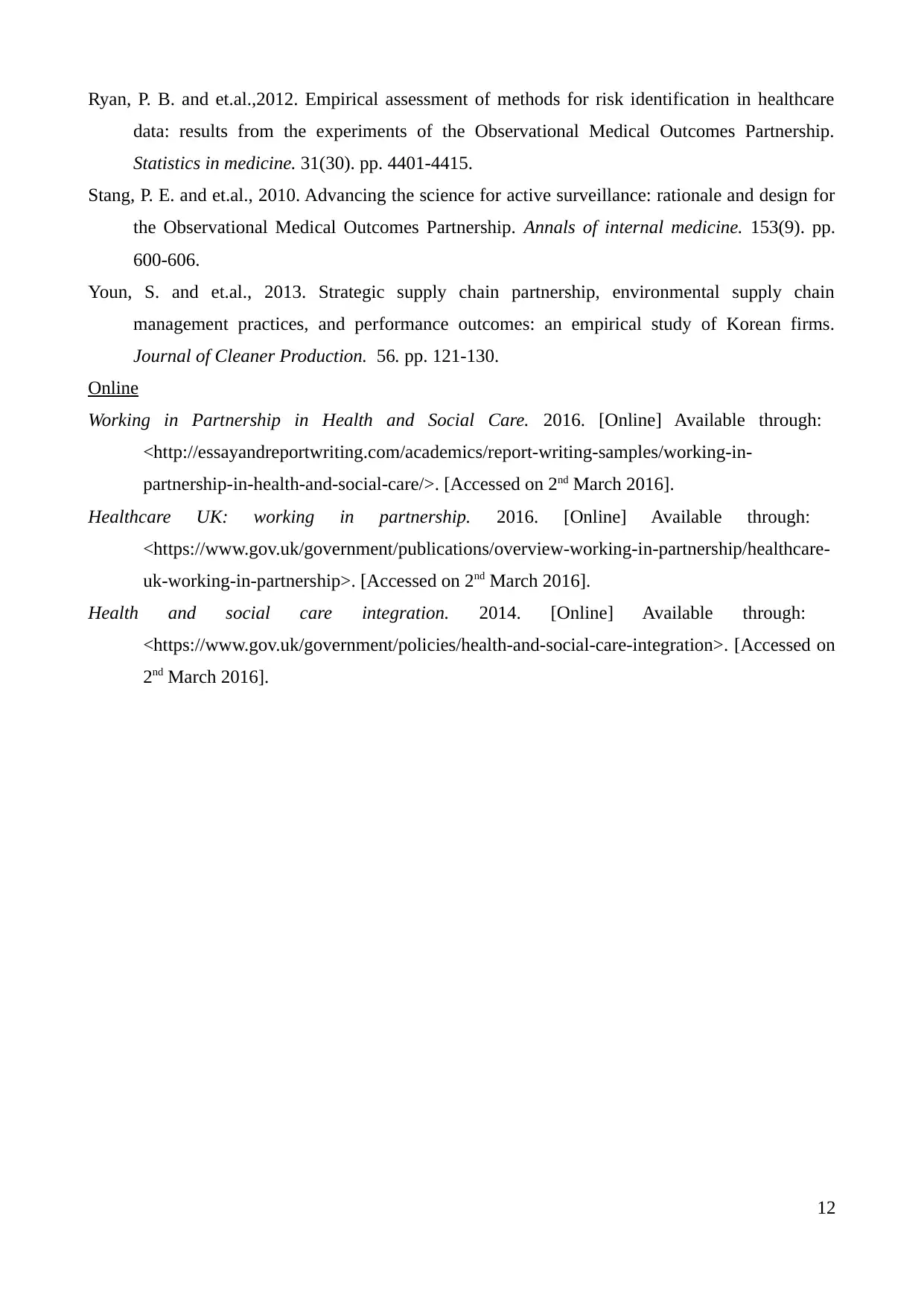
Ryan, P. B. and et.al.,2012. Empirical assessment of methods for risk identification in healthcare
data: results from the experiments of the Observational Medical Outcomes Partnership.
Statistics in medicine. 31(30). pp. 4401-4415.
Stang, P. E. and et.al., 2010. Advancing the science for active surveillance: rationale and design for
the Observational Medical Outcomes Partnership. Annals of internal medicine. 153(9). pp.
600-606.
Youn, S. and et.al., 2013. Strategic supply chain partnership, environmental supply chain
management practices, and performance outcomes: an empirical study of Korean firms.
Journal of Cleaner Production. 56. pp. 121-130.
Online
Working in Partnership in Health and Social Care. 2016. [Online] Available through:
<http://essayandreportwriting.com/academics/report-writing-samples/working-in-
partnership-in-health-and-social-care/>. [Accessed on 2nd March 2016].
Healthcare UK: working in partnership. 2016. [Online] Available through:
<https://www.gov.uk/government/publications/overview-working-in-partnership/healthcare-
uk-working-in-partnership>. [Accessed on 2nd March 2016].
Health and social care integration. 2014. [Online] Available through:
<https://www.gov.uk/government/policies/health-and-social-care-integration>. [Accessed on
2nd March 2016].
12
data: results from the experiments of the Observational Medical Outcomes Partnership.
Statistics in medicine. 31(30). pp. 4401-4415.
Stang, P. E. and et.al., 2010. Advancing the science for active surveillance: rationale and design for
the Observational Medical Outcomes Partnership. Annals of internal medicine. 153(9). pp.
600-606.
Youn, S. and et.al., 2013. Strategic supply chain partnership, environmental supply chain
management practices, and performance outcomes: an empirical study of Korean firms.
Journal of Cleaner Production. 56. pp. 121-130.
Online
Working in Partnership in Health and Social Care. 2016. [Online] Available through:
<http://essayandreportwriting.com/academics/report-writing-samples/working-in-
partnership-in-health-and-social-care/>. [Accessed on 2nd March 2016].
Healthcare UK: working in partnership. 2016. [Online] Available through:
<https://www.gov.uk/government/publications/overview-working-in-partnership/healthcare-
uk-working-in-partnership>. [Accessed on 2nd March 2016].
Health and social care integration. 2014. [Online] Available through:
<https://www.gov.uk/government/policies/health-and-social-care-integration>. [Accessed on
2nd March 2016].
12
⊘ This is a preview!⊘
Do you want full access?
Subscribe today to unlock all pages.

Trusted by 1+ million students worldwide
1 out of 12
Related Documents
Your All-in-One AI-Powered Toolkit for Academic Success.
+13062052269
info@desklib.com
Available 24*7 on WhatsApp / Email
![[object Object]](/_next/static/media/star-bottom.7253800d.svg)
Unlock your academic potential
Copyright © 2020–2025 A2Z Services. All Rights Reserved. Developed and managed by ZUCOL.





